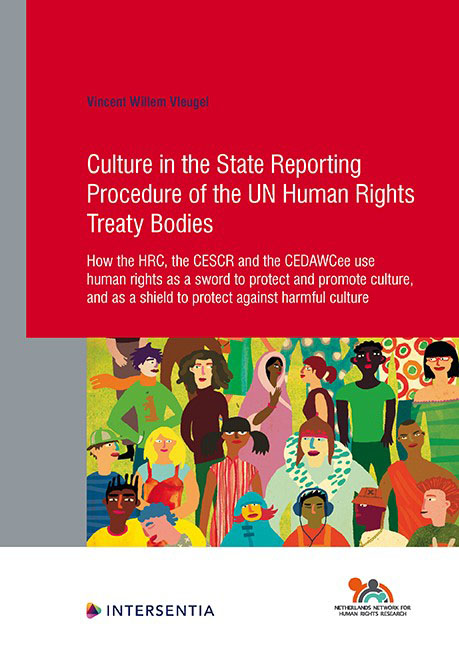 Culture in the State Reporting Procedure of the UN Human Rights Treaty Bodies
Culture in the State Reporting Procedure of the UN Human Rights Treaty Bodies Book contents
- Frontmatter
- Acknowledgements
- Contents
- Abbreviations
- Note on Citation Formats
- Note on Grammar
- Chapter 1 Introduction
- Chapter 2 Human Rights and Cultural Diversity. Between and Beyond Universalism and Cultural Relativism
- Chapter 3 UN Treaty Bodies. Treaties, Committees, Working Methods
- Chapter 4 Human Rights as a Sword. To Protect and Promote Cultural Diversity
- Chapter 5 Human Rights as a Shield. To Protect against Harmful Aspects of Culture
- Chapter 6 Cultural Argumentation. The State Reporting Procedure as a Platform for Cross-Cultural Dialogue
- Chapter 7 Conclusions. How the Treaty Bodies Universalise Human Rights
- Bibliography
- Summary
- Samenvatting
- Human Rights Research Series
Chapter 1 - Introduction
Published online by Cambridge University Press: 11 November 2021
- Frontmatter
- Acknowledgements
- Contents
- Abbreviations
- Note on Citation Formats
- Note on Grammar
- Chapter 1 Introduction
- Chapter 2 Human Rights and Cultural Diversity. Between and Beyond Universalism and Cultural Relativism
- Chapter 3 UN Treaty Bodies. Treaties, Committees, Working Methods
- Chapter 4 Human Rights as a Sword. To Protect and Promote Cultural Diversity
- Chapter 5 Human Rights as a Shield. To Protect against Harmful Aspects of Culture
- Chapter 6 Cultural Argumentation. The State Reporting Procedure as a Platform for Cross-Cultural Dialogue
- Chapter 7 Conclusions. How the Treaty Bodies Universalise Human Rights
- Bibliography
- Summary
- Samenvatting
- Human Rights Research Series
Summary
INTRODUCTION
Every year from mid-November until 5 December, Sinterklaas is celebrated in the Netherlands. He is a figure based on Saint Nicholas, patron saint of children. While there are many legends, very little is known about the historical Saint Nicholas. However, the Sinterklaas tradition has a long history. Apparently, it dates back to medieval times, but the ancient celebrations were very different from the ones existing in the present day. The present representation of Sinterklaas is believed to have its origin in a book published around 1850. The book introduces a narrative in which Sinterklaas comes from Spain and has a servant (‘knecht’). The servant is a black character named Zwarte Piet (‘Black Pete’). The tradition has been subject to much more change since then. As a case in point, Zwarte Piet used to be depicted as a devilish figure in charge of punishing naughty children. Nowadays, he is portrayed as witty, acrobatic, and smart.
Should a Dutch person be asked about something typically Dutch, Sinterklaas is likely to be mentioned, along with tulips, windmills, weed and cheese. It has become a family tradition, celebrated annually with the giving of gifts on St. Nicholas’ Eve (5 December). In 2015, it was included on the country's official cultural heritage list. However, the tradition has become controversial. The figure of Zwarte Piet is said to be ‘racist’ and a symbol of the days of slavery and colonialism. While some criticize and challenge the negative and stereotyping aspects of the tradition, others try to protect and safeguard what they believe to be an indispensable part of a Dutch cultural tradition.
In 2015, the Sinterklaas tradition was the subject of discussion before the Committee on the Elimination of Racial Discrimination (CERD), the expert body of the United Nations tasked with monitoring the implementation of the Convention on the Elimination of All Forms of Racial Discrimination (ICERD) by its States parties. When the CERD received a delegation from the Netherlands to ask questions and request additional information and clarification regarding the State party's efforts to implement the provisions of the Convention, some of the Committee members (independent experts) expressed concern about the Sinterklaas tradition.
- Type
- Chapter
- Information
- Culture in the State Reporting Procedure of the UN Human Rights Treaty BodiesHow the HRC, the CESCR and the CEDAWCee use human rights as a sword to protect and promote culture, and as a shield to protect against harmful culture, pp. 1 - 16Publisher: IntersentiaPrint publication year: 2020


